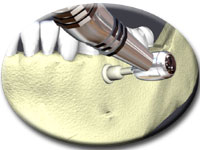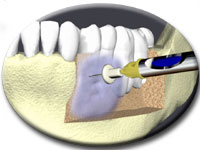Oral Bacteria found in Heart Tissue, how to treat excessive Gum Display, Laser in Endo
Detection of oral bacteria in cardiovascular specimens
Oral Microbiology and Immunology -Volume 24 Issue 1, Pages 64 - 68
Background/aims: Oral bacteria, including cariogenic and periodontal pathogens, are thought to be etiological factors in the development of cardiovascular diseases. To define this relationship, we analyzed the distribution of oral bacterial species in cardiovascular specimens.
Method: Following acceptance into the study, 203 consecutive patients were analyzed, from whom 82 aortic valve specimens, 35 mitral valve specimens, and 86 aortic aneurysmal wall specimens, of which 16 contained aneurysmal thrombus tissues, were obtained. In addition, a total of 58 dental plaque specimens were collected from the same group of patients who underwent heart valve replacement or removal of aortic aneurysms. Bacterial DNA was extracted from both cardiovascular tissues and dental plaque in those cases and then species-specific polymerase chain reaction assays were used to analyze the occurrences of six oral streptococcal and six periodontal bacterial species.
Results: Streptococcus mutans was the most frequently detected species in the cardiovascular specimens, followed by Aggregatibacter actinomycetemcomitans. As for dental plaque specimens from patients who underwent cardiovascular operations, most of the tested periodontitis-related species as well as oral streptococci were detected at high frequencies. Furthermore, the positive rate of S. mutans in cardiovascular specimens from patients whose dental plaque specimens were also positive for S. mutans was 78%, which was significantly higher than any other tested species when the same analysis was performed.
Conclusion: Our results suggest that specific oral bacterial species, such as S. mutans and A. actinomycetemcomitans, are related to bacteremia and may be etiologic factors for the development of cardiovascular diseases.
BIOLASE Announces First Nationally Televised Laser Root Canal Procedure to Be Broadcast January 8
the world's leading dental laser company, today announced that the nationally syndicated TV show "The Doctors" is scheduled to broadcast a root canal procedure performed using BIOLASE's Endolase(TM) RFT Root Canal Therapy System on Thursday, January 8.
The procedure, videotaped on November 10, was performed live by Dr. Darrell Chun, a leading Waterlase Dentist. The entire root canal procedure, performed using a Waterlase® MD YSGG laser system and Endolase(TM) radial firing laser tips, was completed without numbing this dental-phobic patient, who had previously experienced a very painful, traditional root canal.
BIOLASE Chief Executive Officer Jake St. Philip said, "This is great exposure for our dental laser systems and provides an opportunity for viewers to see firsthand what a difference this advancement can do for a notoriously painful dental experience. We believe laser dentistry is becoming an emerging standard, enhancing outcomes and providing a more comfortable patient experience."
In March of this year, the Company received U.S. Food and Drug Administration (FDA) 510(k) clearance of its Waterlase MD with RFT endoTips for root canal disinfection after endodontic instrumentation, making BIOLASE the first company to receive clearances that allow dentists to treat infected, painful toothaches with advanced laser technology. To watch Video Click HERE
Oral Microbiology and Immunology -Volume 24 Issue 1, Pages 64 - 68
Background/aims: Oral bacteria, including cariogenic and periodontal pathogens, are thought to be etiological factors in the development of cardiovascular diseases. To define this relationship, we analyzed the distribution of oral bacterial species in cardiovascular specimens.
Method: Following acceptance into the study, 203 consecutive patients were analyzed, from whom 82 aortic valve specimens, 35 mitral valve specimens, and 86 aortic aneurysmal wall specimens, of which 16 contained aneurysmal thrombus tissues, were obtained. In addition, a total of 58 dental plaque specimens were collected from the same group of patients who underwent heart valve replacement or removal of aortic aneurysms. Bacterial DNA was extracted from both cardiovascular tissues and dental plaque in those cases and then species-specific polymerase chain reaction assays were used to analyze the occurrences of six oral streptococcal and six periodontal bacterial species.
Results: Streptococcus mutans was the most frequently detected species in the cardiovascular specimens, followed by Aggregatibacter actinomycetemcomitans. As for dental plaque specimens from patients who underwent cardiovascular operations, most of the tested periodontitis-related species as well as oral streptococci were detected at high frequencies. Furthermore, the positive rate of S. mutans in cardiovascular specimens from patients whose dental plaque specimens were also positive for S. mutans was 78%, which was significantly higher than any other tested species when the same analysis was performed.
Conclusion: Our results suggest that specific oral bacterial species, such as S. mutans and A. actinomycetemcomitans, are related to bacteremia and may be etiologic factors for the development of cardiovascular diseases.
BIOLASE Announces First Nationally Televised Laser Root Canal Procedure to Be Broadcast January 8
the world's leading dental laser company, today announced that the nationally syndicated TV show "The Doctors" is scheduled to broadcast a root canal procedure performed using BIOLASE's Endolase(TM) RFT Root Canal Therapy System on Thursday, January 8.
The procedure, videotaped on November 10, was performed live by Dr. Darrell Chun, a leading Waterlase Dentist. The entire root canal procedure, performed using a Waterlase® MD YSGG laser system and Endolase(TM) radial firing laser tips, was completed without numbing this dental-phobic patient, who had previously experienced a very painful, traditional root canal.
BIOLASE Chief Executive Officer Jake St. Philip said, "This is great exposure for our dental laser systems and provides an opportunity for viewers to see firsthand what a difference this advancement can do for a notoriously painful dental experience. We believe laser dentistry is becoming an emerging standard, enhancing outcomes and providing a more comfortable patient experience."
In March of this year, the Company received U.S. Food and Drug Administration (FDA) 510(k) clearance of its Waterlase MD with RFT endoTips for root canal disinfection after endodontic instrumentation, making BIOLASE the first company to receive clearances that allow dentists to treat infected, painful toothaches with advanced laser technology. To watch Video Click HERE
Gummy Smiles: The Challenge of Gingival Excess: Prevalence and Guidelines for Clinical Management - Sem in ortho dec 08
Orthodontic treatment planning should be a multidisciplinary approach to achieve periodontal health and maximal esthetics. The presence of altered passive eruption may complicate treatment in the presence of inflammation and compromise esthetic outcomes. The prevalence, diagnosis, and treatment of active and arrested passive eruption in the orthodontic patient will be the focus of this article. In a recent landmark study, the prevalence of altered passive eruption in postorthodontic patients, and the same patients 5 years after treatment, were studied for their need for periodontal plastic surgery, esthetic crown lengthening. Less than ideal smile characteristics, namely length-to-width ratios and asymmetry, were found in 65% and 60% of patients, respectively. Enhancing orthodontic results and providing the patient with maximal esthetic results can be achieved through the control of inflammation and esthetic crown lengthening.
Next-Generation Cell Phones in 2009, wait before you buy your next mobile handset
you decided to take the smartphone plunge in 2008 and pick up an iPhone 3G or a T-Mobile G1, based on Google's Android. That's great. But consider yourself warned: You might soon feel a bit of buyer's remorse. Why? Next year's crop of cell phones is right around the corner, and these shiny new models may have you wishing you had held out a little longer before signing a multiyear contract with a wireless carrier and snapping up a new handset.
What can you expect in 2009? You can look forward to smartphones that sport razor-sharp displays, lightning-fast processing speeds and built-in videoconferencing capabilities, as well as phones with cameras that have the potential to put your point-and-shoot to shame.
I wouldn't bet my iPod that absolutely all of the phones in this slide show will be available in 2009. Most will, but some may never make it. I selected only the phones I think have the best chance of surfacing in the United States in 2009. Read on for a peek at new upcoming models click HERE
What can you expect in 2009? You can look forward to smartphones that sport razor-sharp displays, lightning-fast processing speeds and built-in videoconferencing capabilities, as well as phones with cameras that have the potential to put your point-and-shoot to shame.
I wouldn't bet my iPod that absolutely all of the phones in this slide show will be available in 2009. Most will, but some may never make it. I selected only the phones I think have the best chance of surfacing in the United States in 2009. Read on for a peek at new upcoming models click HERE
Patients With Diabetes pay lower medical cost if Gums are healty
December 27th, 2008
A new report suggests that treating gum disease in patients who have diabetes with procedures such as cleanings and periodontal scaling is linked to 10 to 12 percent lower medical costs per month.
The findings are encouraging but the study was not designed to firmly establish cause and effect, said George Taylor, University of Michigan associate professor of dentistry, who also has an appointment in epidemiology in the U-M School of Public Health. Taylor led the research project to investigate whether routine, non-surgical treatment for gum disease is linked to lower medical care costs for people with diabetes.
“Cleanings and other non-surgical periodontal treatment remove the harmful bacteria,” Taylor said. “We believe this helps prevent the body from producing those harmful chemicals that can enter the systemic circulation and contribute to poorer diabetes control.” More HERE
A new report suggests that treating gum disease in patients who have diabetes with procedures such as cleanings and periodontal scaling is linked to 10 to 12 percent lower medical costs per month.
The findings are encouraging but the study was not designed to firmly establish cause and effect, said George Taylor, University of Michigan associate professor of dentistry, who also has an appointment in epidemiology in the U-M School of Public Health. Taylor led the research project to investigate whether routine, non-surgical treatment for gum disease is linked to lower medical care costs for people with diabetes.
“Cleanings and other non-surgical periodontal treatment remove the harmful bacteria,” Taylor said. “We believe this helps prevent the body from producing those harmful chemicals that can enter the systemic circulation and contribute to poorer diabetes control.” More HERE


